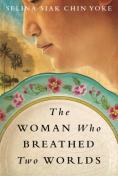BKMT READING GUIDES
The Woman Who Breathed Two Worlds (The Malayan Series)
by Selina Siak Chin Yoke
Paperback : 474 pages
0 club reading this now
0 members have read this book
Facing challenges in an increasingly colonial world, Chye Hoon, a rebellious young girl, must learn to embrace her mixed Malayan-Chinese identity as a Nyonya—and her destiny as a cook, rather than following her first dream of attending school like her brother.
Amidst the smells of ...
Introduction
Facing challenges in an increasingly colonial world, Chye Hoon, a rebellious young girl, must learn to embrace her mixed Malayan-Chinese identity as a Nyonya—and her destiny as a cook, rather than following her first dream of attending school like her brother.
Amidst the smells of chillies and garlic frying, Chye Hoon begins to appreciate the richness of her traditions, eventually marrying Wong Peng Choon, a Chinese man. Together, they have ten children. At last, she can pass on the stories she has heard—magical tales of men from the sea—and her warrior’s courage, along with her wonderful kueh (cakes).
But the cultural shift towards the West has begun. Chye Hoon finds herself afraid of losing the heritage she so prizes as her children move more and more into the modernising Western world.
Excerpt
PROLOGUE 1938‘In the days when genies roamed this valley of tin and tears, a warrior arose from among our people. His name was Hang Tuah, and he carried a magic sword.’
When I told my granddaughter the story of this fearsome warrior, it was a sultry Malayan afternoon, so hot that even the neighbourhood dogs would not settle. Through the open window came a baying chorus, eerie like sounds of the jungle, instead of the calming breezes I so loved, sublime breath of the gods that usually blew in from the limestone hills beyond. ...
Discussion Questions
1. Have you read other novels set in Asia? In what way does The Woman who Breathed Two Worlds differ from other novels for you?2. What did you like most about Chye Hoon and what did you like least?
3. A unique aspect of this novel is the way in which the author has chosen to change word order in parts of the dialogue. Did her use of colloquial dialogue help situate you more profoundly in Chye Hoon’s world or did you find the dialogue jarring?
4. What are the lessons you took away from this book?
5. “‘My friend, you wrong before that time,’ I said. ‘I no hate anyone – white skins people too, like us. But they put on airs here.’
Siew Lan muttered a protest, which I ignored. ‘Yes, I tell you! They look at me, they not really look – like I not there at all. Like I just thin air in front of them, invisible.’”
The conversation above, between Chye Hoon and her best friend Siew Lan, takes place shortly before the latter’s marriage to Stuart McPherson. Have you ever felt invisible in your own life? Conversely, have you had feelings of condescension towards members of the local population while travelling through non-Western countries? How do you think they felt about you?
6. Discuss the similarities and differences between Siew Lan and Chye Hoon. To what extent do you think Siew Lan was able to influence her friend?
7. Chye Hoon’s struggle to adapt to creeping Westernisation is epitomised by her suspicion of Western medicine and hospitals, especially where childbirth is concerned:
“In any case, babies were different: I could see no reason for not having them in the comfort of one’s own home. I had once had the misfortune of stepping into a hospital when I visited a sick Nyonya who was one of my customers, and I couldn’t imagine the indignity of lying in such a large room among strangers, being barked at by a doctor, a man, who told you to push . . . pu-u-sh . . . without ever conceivably knowing what your pain must feel like.”
Do you think her views have any validity?
8. What, if anything, in this novel surprised you?
9. Chye Hoon worked hard to feed, clothe and house her children but she failed to mould their characters. Do you agree or disagree with this statement?
10. The relationship between Chye Hoon and her eldest son, Weng Yu, forms a central focus in the story. Discuss her reaction when she learns of his attachment to a white woman, Helen, in the context of what you know about the world in the 1920s. What would you have done in Chye Hoon’s shoes?
Weblinks
| » |
Author's web site
|
| » |
Book review from Literary Dust
|
| » |
Book review from E.P. Clark
|
| » |
Book Review from Feminism in Cold Storage
|
Book Club Recommendations
Recommended to book clubs by 0 of 0 members.
Book Club HQ to over 88,000+ book clubs and ready to welcome yours.
Get free weekly updates on top club picks, book giveaways, author events and more








